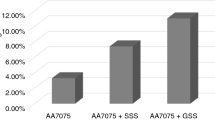The Uzbekistan Republic does not produce aluminum alloys in spite of their enormous demand. Primarily this concerns the engineering industry. Further development of engineering, expansion of equipment production and structures is impossible without using aluminum alloys. This article provides results of a study of formation during crystallization of aluminum alloy structure from scrap and waste. Versions are shown for producing the optimum structure of secondary alloys. Methods and a scientific approach are considered in the article used for other groups of alloys that it is possible to develop of the basis of the Navoi Mining and Metallurgical Combine production.




Similar content being viewed by others
References
N. A. Belov, A. A. Aksenov, and D. G. Eskin, Multicomponent Phase Diagrams: Applications for Commercial Aluminum Alloys, Elsevier (2005).
V. S. Zolotorevskiy, N. A. Belovand, and M. V. Glazoff, Casting Aluminum Alloys, Elsevier (2007)..
D. E. Eskin, A. Suyitno, and L. Katgerman, “Mechanical properties in the semi-solid state and hot tearing of aluminium alloys,” Progress in Mat. Science,49, No. 5, 630–711 (2004).
C. Sung-Hwan, S. Si-Young, C. Hyun-Joo, et al., “High temperature tensile deformation behavior of new heat resistant aluminum alloy,” Proc. Eng.,10, 159–164 (2011).
N. A. Belov, E. A. Naumova, V. V. Doroshenko, and T. A. Bazlova, “Effect of manganese and iron on the phase composition and microstructure of aluminum-calcium alloys,” Tsvetn. Metally, No. 8, 66–71 (2017).
A. A. Andreeva, S. Yu. Mansurov, D. V. Miklushevskiy, and Yu. N. Mansurov, “Model of formation of innovation process for large industrial enterprises,” Tsvetn. Metally,3, 74–77 (2015).
Yu. N. Mansurov, V. P. Reva, S. Yu. Mansurov, and M. V. Beloborodov, “Economic and social basis of material science development in the far east,” Tsvetn. Metally,11, 88–93 (2016).
D. V. Miklushevskiy, S. Y. Mansurov, T. N. Piterskaya, and Yu. N. Mansurov, “Economy and innovation management of universities,” Tsvetn. Metally,9, 6–12 (2015).
P. Uliasz, T. Knych, A. Mamala, and B. Smyrak, “Investigation in properties design of heat resistant AlZrSc alloy wires assigned for electrical application,” in: Aluminium Alloys: Their Physical and Mechanical Properties (2008), pp. 248–255.
Yu. N. Mansurov, N. A. Belov, A. V. Sannikov, and I. Yu. Buravlev, “Optimization of composition and properties of heat resistant complex-alloyed aluminum alloy castings,” Non-Ferrous Metals,39. No. 2, 48–55 (2015).
A. A. Aksenov, Y. N. Mansurov, V. P. Reva, et al., “Mechanical alloying of secondary raw material for foam aluminum production,” Metallurgist,61, No. 5-6, 475–484 (2017).
Yu. N. Mansurov, E. I. Kurbatkina, I. Yu. Buravlev, and V. P. Reva, “Features of structure’s formation and properties of composite aluminum alloy ingots,” Nonferrous Metals,39, No. 2, 40–47 (2015).
J. Qiu, Y. Liu, F. Meng, et al., “Effects of environment on dry sliding wear of powder metallurgical Ti–47Al–2Cr–2Nb–0.2W,” Intermetallics,53, 10–19 (2014).
J. Cheng, Y. Yu, L. Fu, et al., “Effect of TiB2 on dry-sliding tribological properties of TiAl intermetallics,” Tribol. Int.,62, 91–99 (2013).
A. V. Kartavykh, M. V. Gorshenkov, V. D. Danilov, et al., “Tribochemistry of dry-sliding wear of structural TiAl (Nb, Cr, Zr) B, La intermetallics family against the chromium steel,” Tribol. Int.,90, 270–277 (2015).
K. Knipling, D. Dunand, and D. Seidman, “Precipitation evolution in Al–Zr and Al–Zr–Ti alloys during isothermal aging at 375–425°C,” Acta Mater.,56, 114–127 (2008).
W. Lefebvre, F. Danoix, H. Hallem, et al., “Precipitation kinetic of Al3(Sc, Zr) dispersoids in aluminium,” J. Alloys Compd.,470, 107–110 (2009).
Author information
Authors and Affiliations
Corresponding author
Additional information
Translated from Metallurg, Vol. 63, No. 12, pp. 60–66, December, 2019. Original article July 13, 2019.
Rights and permissions
About this article
Cite this article
Mansurov, Y.N., Rikhsiboev, A.R. & Mansurov, S.Y. Features of Multicomponent Secondary Aluminium Alloy Structure Formation. Metallurgist 63, 1303–1312 (2020). https://doi.org/10.1007/s11015-020-00952-7
Published:
Issue Date:
DOI: https://doi.org/10.1007/s11015-020-00952-7




